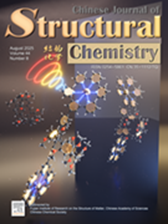
Cover Picture
Metal-coordinate complexes (M = 3d, 4f) with enhanced circularly polarized luminescence in planar chiral pillar[5]arenes
Yu Tian, Yijun Lin, Siyu Deng, Yinghe Tan, Xuanyi Bie, Zhaoyang Chen, Pangkuan Chen* Submit a Manuscript
Metal-coordinate complexes (M = 3d, 4f) with enhanced circularly polarized luminescence in planar chiral pillar[5]arenes
Yu Tian, Yijun Lin, Siyu Deng, Yinghe Tan, Xuanyi Bie, Zhaoyang Chen, Pangkuan Chen* Submit a Manuscript
Regulating the oxygen vacancies in Ni-CexZr1-xO2/ZSM-5 to improve the long-term stability for dry reforming of methane
Zhuwei Yang, Linsen Li, Yijie Lin, Xinyuan Tao, Xiao Liu, Lei Chen, Ming Ma, Li Lin*, Riguang Zhang*, Jiayuan Li, Zhao Jiang*
Chin. J. Struct. Chem., 2025, 44(8), 100632. DOI: 10.1016/j.cjsc.2025.100632
August 1, 2025
Ni; CexZr1-xO2; ZSM-5; Methane dry reforming; Oxygen vacancy
ABSTRACT
Methane dry reforming (DRM) has gained significant attention as a promising route to convert two major greenhouse gases (CO2 and CH4) to syngas. The development of efficient catalysts is critical for the engineering applications. In this study, the CexZr1-xO2/ZSM-5 composites with different oxygen vacancy concentrations were synthesized by tuning the Ce/Zr ratio, followed by the deposition of metal Ni to the island-like CexZr1-xO2 on the ZSM-5, forming a variety of Ni-CexZr1-xO2/ZSM-5 catalysts, which were applied for the methane dry reforming reaction under 750°C. Combined with various characterizations, it was found that the oxygen vacancy concentration illustrated the volcanic tendency with the decreased Ce/Zr ratio, and the interaction between metal Ni and CexZr1-xO2 exhibited a positive relationship with oxygen vacancy concentration. The enhanced between Ni and CexZr1-xO2 interaction could improve the strength and amount of Ni-O-M (M=Ce/Zr) species, making the d-band centers of catalysts closer to the Fermi energy level, which was beneficial to the CH4 and CO2 activation, along with the improved capacity to resist sintering and coking. Especially, the C1Z3 (Ni-Ce0.25Zr0.75O2/ZSM-5) catalyst with the Ce/Zr ratio of 1/3 demonstrated the optimal catalytic performance with 91.9% CH4 and 93.8% CO2 conversions within 50 h, accompanied by the best structural and catalytic stability after 100 h. In-situ DRIFTS was employed to study the reaction path and mechanism, discovering that significant amounts of strengthened Ni-O-M species were conducive to activating adsorbed CH4 and CO2, and desorbing the linear CO species.







